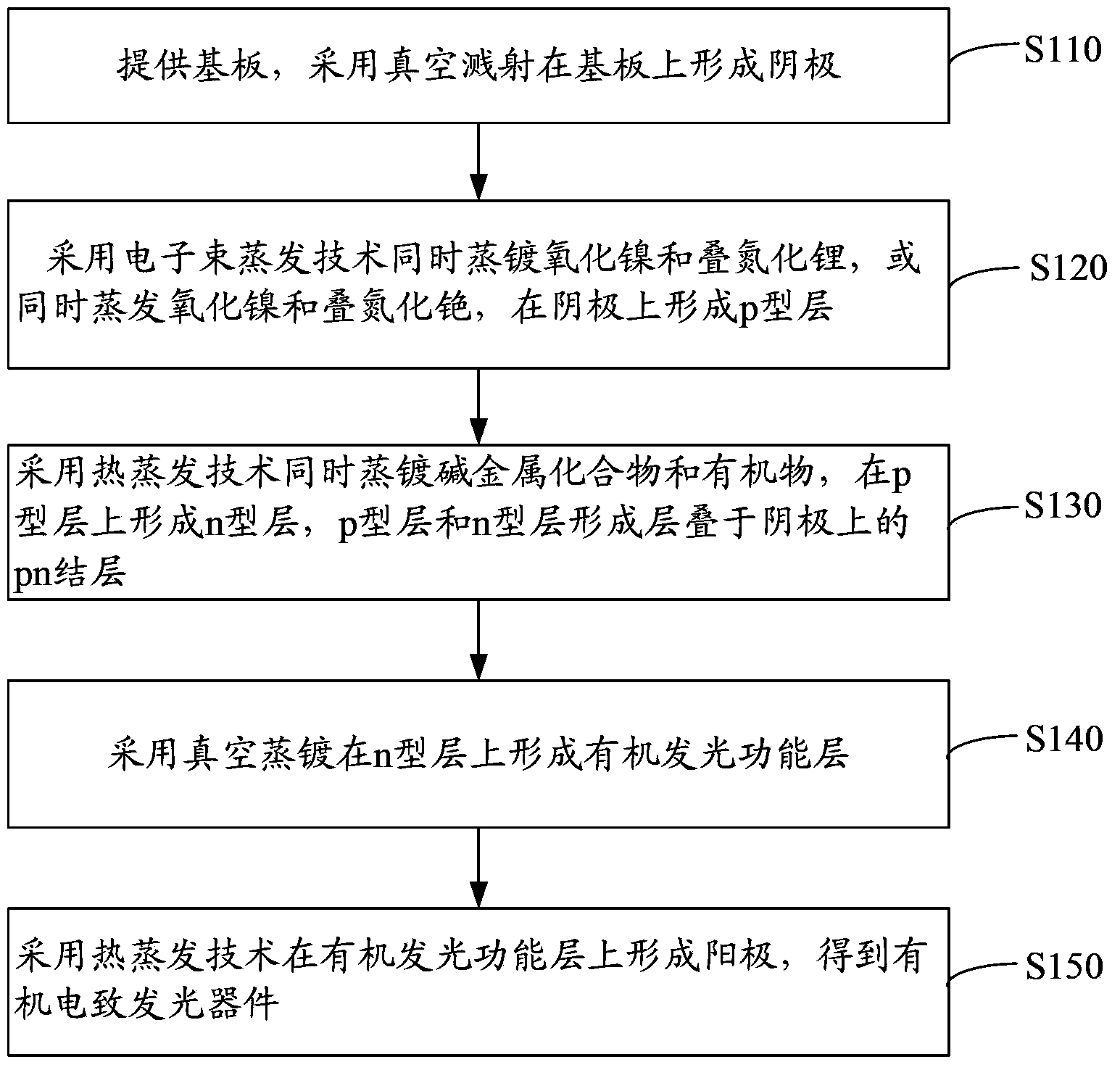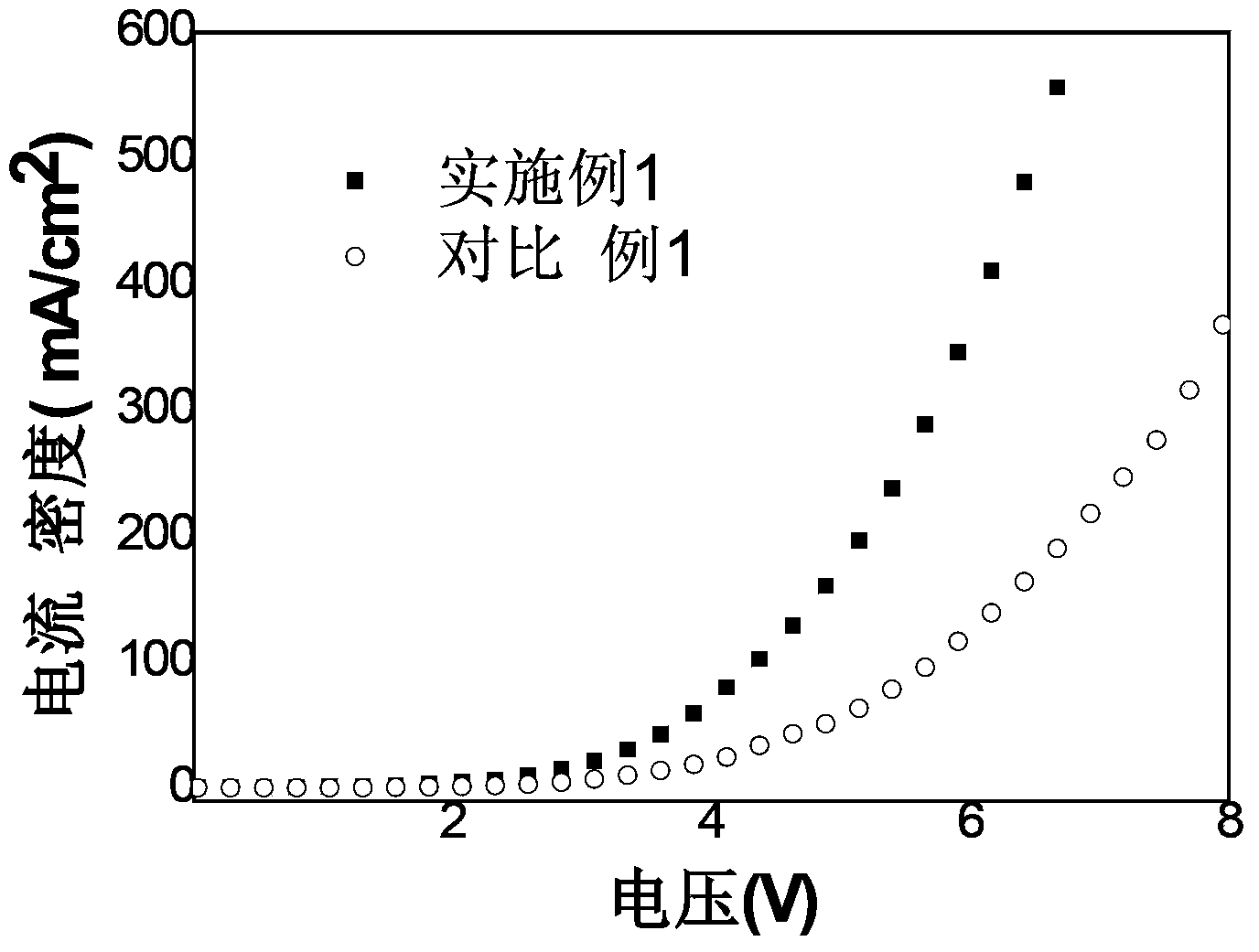Inversion-type organic light-emitting device and preparation method thereof
An electroluminescent device, an inverted technology, applied in the direction of electrical solid-state devices, semiconductor/solid-state device manufacturing, electrical components, etc., can solve the problems of high work function, unfavorable electron injection, and difficulty in improving the luminous efficiency of the device, so as to improve the luminescence Efficiency, the effect of solving the difficulty of carrier injection
- Summary
- Abstract
- Description
- Claims
- Application Information
AI Technical Summary
Problems solved by technology
Method used
Image
Examples
preparation example Construction
[0054] see figure 2 , the preparation method of the inverted organic electroluminescence device of one embodiment, comprises the following steps:
[0055] Step S110: providing a substrate, and forming a cathode on the substrate by vacuum sputtering.
[0056] The substrate adopts a transparent glass substrate. Put the transparent glass substrate in deionized water containing detergent for ultrasonic cleaning. After cleaning, it was treated with isopropanol and acetone in ultrasonic for 20 minutes, and then dried with nitrogen.
[0057] at 5×10 -4 Under the vacuum degree of Pa, sputter indium tin oxide (ITO), indium zinc oxide (IZO), aluminum zinc oxide (AZO) or gallium zinc oxide (GZO) on a clean and dry glass substrate, A cathode is formed on a glass substrate.
[0058] The thickness of the cathode is preferably 70 to 200 nanometers.
[0059] Step S120: Simultaneously vapor-deposit nickel oxide and lithium azide, or simultaneously vaporize nickel oxide and cesium azide, ...
Embodiment 1
[0090] The structure is: Glass / ITO / Li:NiO / Li 2 CO 3 :Alq 3 / PBD / DCJTB:Alq 3 Fabrication of Inverted Organic Electroluminescent Devices Based on / CuPc / Ag
[0091] (1) Provide a transparent glass substrate, expressed as Glass. Place the glass substrate in deionized water containing detergent for ultrasonic cleaning. After cleaning, treat it with isopropanol and acetone in ultrasonic for 20 minutes, and then dry it with nitrogen;
[0092] (2) In a vacuum of 5×10 -4 In Pa's vacuum coating system, indium tin oxide (ITO) is sputtered onto a clean and dry glass substrate, and a cathode is formed on the glass substrate, denoted as ITO. The thickness of the cathode is 100 nanometers;
[0093] (3) In a vacuum of 5×10 -4 In Pa's vacuum coating system, nickel oxide (NiO) and lithium azide (LiN 3 ), to obtain a metal Li-doped NiO thin film, forming a p-type layer stacked on the cathode. The p-type layer is expressed as Li:NiO, wherein Li accounts for 5% by mass of the p-type layer...
Embodiment 2
[0099] The structure is Glass / AZO / Cs:NiO / CsN 3 : Fabrication of Bphen / BCP / Rubrene / ZnPc / Au Inverted Organic Electroluminescent Devices
[0100] (1) Provide a transparent glass substrate, expressed as Glass. Place the glass substrate in deionized water containing detergent for ultrasonic cleaning. After cleaning, treat it with isopropanol and acetone in ultrasonic for 20 minutes, and then dry it with nitrogen;
[0101] (2) In a vacuum of 5×10 -4 In Pa's vacuum coating system, aluminum zinc oxide (AZO) is sputtered onto a clean and dry glass substrate, and a cathode is formed on the glass substrate, denoted as AZO. The thickness of the cathode is 70 nanometers;
[0102] (3) In a vacuum of 5×10 -4 In Pa's vacuum coating system, nickel oxide (NiO) and cesium azide (CsN 3 ), to obtain a metal Cs-doped NiO film to form a p-type layer stacked on the cathode. The p-type layer is expressed as Cs:NiO, wherein the mass percentage of Cs in the p-type layer is 1%, and the thickness of...
PUM
| Property | Measurement | Unit |
|---|---|---|
| Thickness | aaaaa | aaaaa |
| Thickness | aaaaa | aaaaa |
| Thickness | aaaaa | aaaaa |
Abstract
Description
Claims
Application Information
 Login to View More
Login to View More - R&D
- Intellectual Property
- Life Sciences
- Materials
- Tech Scout
- Unparalleled Data Quality
- Higher Quality Content
- 60% Fewer Hallucinations
Browse by: Latest US Patents, China's latest patents, Technical Efficacy Thesaurus, Application Domain, Technology Topic, Popular Technical Reports.
© 2025 PatSnap. All rights reserved.Legal|Privacy policy|Modern Slavery Act Transparency Statement|Sitemap|About US| Contact US: help@patsnap.com



